.jpg) English name: Sacred fig
English name: Sacred fig
Botanical name: Ficus religiosa
Medicinal uses: Fruits and tender buds of Arayal are used as laxative. Infusion is used for ulcers and skin troubles. Bark is used for liver diseases.
English name:Neem
Botanical name: Azadirachta indica
Medicinal uses: Bark is used for skin ailments. Leaves are considered antiseptic, applied to boils in the form of poultice. Leaf decoction is given for ulcers and eczema. Neem flower is used as tonic and stomachic. Berries are purgative and emollient. Seeds yield non-drying oil used for skin afflictions. Neem is occasionally obtained as exudation and is used as a tonic. It has excellent viricidal properties.
.jpg)
English name: Asok tree
Botanical name: Saraca indica
Medicinal uses: Asokam flower is used as an astringent and for uterine afflictions. It is also used as a uterine tonic and is excellent in maintaining menstrual rhythm. It is also used for treating depression in women. One of the main medicines made of this is Asokarishtam.
.jpg)
English name: Bhadra
Botanical name: Aerva lanata
Medicinal uses: Balipoovu is used for coughs, sore throat, diabetes and lithiasis. Decoction is used as a diuretic.
.jpg)
English name: Sandalwood
Botanical name: Santalum album
Medicinal uses: Both wood and oil of Chandanam are diuretic, diaphoretic, refrigerant and expectorant.
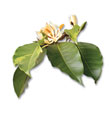
English name: Chempa tree
Botanical name: Michelia champaca
Medicinal uses: Flowers are tonic, stomachic, carminative and used for dyspepsia, nausea, fever and renal diseases. Also used as a diuretic. Oil from flowers is used for cephalagia.
.jpg)
English name: Shoe flower
Botanical name: Hibiscus rosasinensis
Medicinal uses: Flower decoction is given for bronchial catarrh, leaves are anodyne, emollient and aperient.
.jpg)
English name: Shoe flower
Botanical name: Hibiscus rosasinensis
Medicinal uses: Used against hypertrophy of spleen, scurvy and as a carminative.
.jpg)
English name: Vasaka
Botanical name: Adhatoda beddomei
Medicinal uses: Leaf juice is used for haemoptysis and menorrhagia.
.jpg)
English name: Hair leaved moon seed
Botanical name: Tinospora cordifolia
Medicinal uses: Dry twigs of Chittamrith with the bark intact constitute the drug. It is used as anti-spasmodic, antipyretic and anti-inflammatory. Starch prepared from stem is used as a tonic. Effective for diabetes and urinary infections and is used for general debility, dyspepsia and fevers.
.jpg)
English name: Indian stinging nettle
Botanical name: Tragia involucrata
Medicinal uses: It is used as a diaphoretic. Paste prepared from roots is applied for extraction of guinea worms. Mixed with Tulsi juice it is applied to itchy eruptions on the skin. Fruit, a constituent of Kshara Guda, is used for the enlargement of spleen.
.jpg)
English name: Poison berry
Botanical name: Solanum torvum
Medicinal uses: Used for liver and spleen enlargements. Decoction is given for cough. Herb is used as a sedative, diuretic and digestive. Leaves are haemostatic and roots are used as poultice for cracks in the feet.
.jpg)
English name: Sesame
Botanical name: Sesamum indicum
Medicinal uses: Seeds are emollient, lactagogue and diuretic. A plaster made from seeds is applied on wounds. It is also applied on skin eruptions. A paste of sesame seeds mixed with butter is applied for haemorrhoids. It is an important ingredient in anti-fertility drugs.
.jpg)
English name: Gigantic swallow
Botanical name: Calotropis gigantea
Medicinal uses: Root bark is used for leprosy. Leaves are rubbed on the skin of elephants for treatment of Kesarayer disease.
.jpg)
English name: Devils tree
Botanical name: Alstonia scholaris
Medicinal uses: Bark is a bitter tonic, febrifuge, anthelmintic, haemostatic and
galactagogue. Used for chronic diarrhoea, asthma and cardiac troubles. Leaves are used for
beri-beri and congested liver. Flowers act as depressant.
.jpg)
English name: Clove
Botanical name: Syzygium aromaticum
Medicinal uses: Cloves are aromatic, stimulant and carminative. Used for dyspepsia and gastric irritation. Used externally as a counter-irritant. Oil from seeds is employed as analgesic for hyper-sensitive dentines. Also used as an anti-spasmodic.
.jpg)
Botanical name: Zingiber officinale
Medicinal uses: Used as a carminative and stimulant. It is also given for flatulence and colic. It is also an anti-oxidant. Dried rhizomes (Chukku) are used in almost all decoctions.
.jpg)
English name: Nutmeg
Botanical name: Myristica fragrans
Medicinal uses: Recommended for inflammation of urinary passages and bladder. Nutmeg butter or fat obtained from nutmeg is a mild external stimulant used in ointments, hair lotions and plasters. It is also applied for rheumatism, sprains and paralysis. Raw fruit is very effective for all kinds of stomach disorders.
.jpg)
English name: Long zedori
Botanical name: Kaempferia galanga
Medicinal uses: Used as expectorant, cicatrizant, carminative and diuretic. Roasted rhizomes are applied hot on festering tumours.
.jpg)
English name: Rough chap tree
Botanical name: Achyranthes aspera
Medicinal uses:
Decoction of the herb is diuretic and used for renal dropsies. Ash is potassium-rich.
.jpg)
English name: Mustard
Botanical name: Brassica juncea
Medicinal uses: Seeds are diaphoretic and anthelmintic. Decoction of seeds is given for lumbago, cough and indigestion.
.jpg)
English name: Chebulie myroblam
Botanical name: Terminalia chebula
Medicinal uses: Fruits are laxative, stomachic and tonic. Coarsely powdered fruit is smoked for asthma. Bark is diuretic and cardiotonic. Kadukka is one of the main ingredients for the famous Ayurvedic preparation triphala which is used in the treatment of enlarged liver, stomach disorders and pain in the eyes. It is a popular remedy for piles.
.jpg)
English name: Strychnine tree
Botanical name: Strychnos nuxvomica
Medicinal uses: Tonic, stimulant and febrifuge. It is also used in preparations for nervous disorders. Seeds are prescribed for colic and as emetic. Leaves are applied to maggot infested ulcers and the juice from fresh wood is used for dyspepsia.
.jpg)
English name: Catechu tree
Botanical name: Acacia catechu
Medicinal uses: Used for sore throat and coughs. Bark is used in thirst quenching preparations, is an appetizer and is anti-cancerous.
.jpg)
English name: Cinnamon
Botanical name: Cinnamomum zeylanicum
Medicinal uses: Karuvapatta is astringent, carminative, stimulant and checks nausea. Used in the treatment of asthmatic cough and checks formation of free radicals in the body.
.jpg)
English name: Fragrant turmeric
Botanical name: Curcuma aromatica
Medicinal uses: Rhizomes are used for bruises, contusions, sprains etc. Is an antiseptic and is used in cosmetic preparations.
.jpg)
English name: Indian aloes
Botanical name: Aloe vera
Medicinal uses: Fresh juice of Kattar Vazha leaves is cathartic and refrigerant. It is used for liver and spleen ailments and applied on x-ray burns, dermatitis, cutaneous leishmaniasis and other disorders. Extract of the leaves inhibits growth of mycobacterium tuberculosis. Thickened juice of the leaves is used for haemorrhoidal congestion of stomach and spleen, also for prolapsed uterus.
.jpg)
English name: Philanthus
Botanical name: Phyllanthus niruri
Medicinal uses: Used as astringent, deobstruent, stomachic, diuretic and febrifuge. Fresh roots are given for jaundice.
.jpg)
English name: Indian pennywort
Botanical name: Centella asiatica
Medicinal uses: Diuretic and tonic, Kodangal is also used for leprosy. A glycoside, 'asiaticoside' is found to be active in the treatment of leprosy. And is also applied for nerve-disorders.
.jpg)
English name: Rough ginger
Botanical name: Zingiber zerumbet
Medicinal uses: Used for the treatment of cough, asthma, stomach ache, skin diseases and leprosy. Also used as a vermifuge.
.jpg)
English name: Arrowroot
Botanical name: Maranta arundinaceae
Medicinal uses: Used for stomach disorders and as a rubefacient.
.jpg)
English name: Bach tree
Botanical name: Aegle marmelos
Medicinal uses: Unripe or half ripe fruits are used as astringent, digestive, cardiac depressant and stomachic. Pulp is aromatic. Cooled, it is drunk as a sherbet.
.jpg)
English name: Indian sacred basil
Botanical name: Ocimum sanctum
Medicinal uses: Krishna Tulsi is anti-bacterial and mosquito repellent. Leaves can be used as stimulant, diaphoretic, antipyretic and expectorant. Also used for catarrh and cutaneous diseases. Infusion is used as a stomachic. Decoction of roots is given as a diaphoretic for malarial fevers. Seeds are used for genito-urinary diseases.
English name: Indian gamboge
Botanical name: Garcinia cambogea
Medicinal uses: Decoction of rind is given for rheumatism and bowel complaints. A resin is also extracted, which has purgative properties.
English name: Beechwood
Botanical name: Gmelina arborea
Medicinal uses: In Ayurveda, Kumizhu is used as an alternative astringent to the intestinal problems, used as a medicine for growth of hairs and is also useful for anaemia, leprosy, ulcers and vaginal discharge.
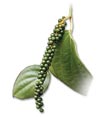
English name: Pepper corns
Botanical name: Piper nigrum
Medicinal uses: Pepper is an aromatic stimulant, used for weakness following fever, as stomachic, antipyretic for malarial fever and applied externally as rubefacient. It is locally applied for sore throat, haemorrhoids and cutaneous troubles.
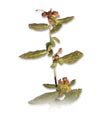
English name: Hornbean leaved sid
Botanical name: Sida acuta
Medicinal uses: A panacea for rheumatism, it is also used against coughs, asthma and bronchitis.
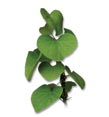
English name: Velvetleaf
Botanical name: Cissampelos pariera
Medicinal uses: Roots are diuretic and purgative and are used for dyspepsia, dropsy, urinary troubles, back pains and Parkinson’s disease.
.jpg)
English name: Trailing eclipta
Botanical name: Eclipta sp.
Medicinal uses: Applied for spleen and liver infections and also as diuretic.
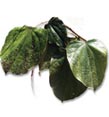
English name: Columbo wood
Botanical name: Coscinium fenestratum
Medicinal uses: Roots are considered bitter tonic and stomachic. Stem yields a yellow dye used for dyspepsia and for dressing wounds and ulcers. Also used as a febrifuge.
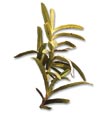
English name: Vanda
Botanical name: Vanda spathulata
Medicinal uses: Dried flowers are powdered and given for consumption, asthma and manic cases. Juice of the plant is given to temper the bile and abate frenzy.

English name: Pomegranate
Botanical name: Punica granatum
Medicinal uses: Bark is used to expel tape worms, rind are used as an astringent and flower buds used for bronchitis. Also used for diarrhoea and dysentery.
.jpg)
English name: Tictrifoil
Botanical name: Pseudarthria viscida
Medicinal uses: Decoction of roots or their powder is used for biliousness, rheumatism, diarrhoea, asthma, cardiac troubles, worms and haemorrhoids.
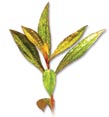
English name: Ayapana tea
Botanical name: Eupatorium triplinerve
Medicinal uses: Used as stimulant, tonic and laxative. Hot infusion is emetic and diaphoretic, decoction of leaves is haemostatic. An aqueous extract of shoots is a cardiac stimulant and is also applied to fresh wounds.
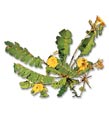
English name: Lajjalu
Botanical name: Biophytum sensitivum
Medicinal uses: Tonic and stimulant, used for chest complaints, convulsions, cramps and inflammatory tumours. Ash mixed with lime juice is given for stomach ache. Leaves and roots are styptic, decoction of leaves is given for diabetes, asthma and phthisis.
English name: Jasmine
Botanical name: Jasminum grandiflorum
Medicinal uses: An aphrodisiac. A yellow dye extracted from the roots is used for ringworm. Milky juice of the bark is used for sinusitis and fistulae.
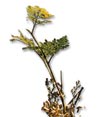
English name: Drumstick tree
Botanical name: Moringa pterygosperma
Medicinal uses: All parts of the tree are used in the treatment of ascites, toxic bites, rheumatism and as cardiac and circulatory stimulants. Roots are rubefacient and vesicant. Leaves are useful for scurvy and catarrhal infections. Flower is diuretic and cholagogue.
Seed is antipyretic.
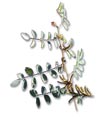
English name: Indian indigo
Botanical name: Indigofera tinctoria
Medicinal uses: Used for epilepsy and nervous disorders. Ointment used for sores, old ulcers and haemorrhoids. Decoction of leaves is given for blennorrhagia. Roots are used for urinary complaints and hepatitis. It is used for making hair oil which promotes hair growth or hair treatment.
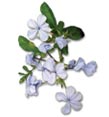
English name: Blue leadwort
Botanical name: Plumbago capensis
Medicinal uses: Decoction is used in black-water fever, roots employed as a styptic for scrofula. Infusion is emetic. Powdered roots are used as a snuff which also removes warts when smeared over them.
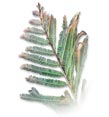
English name: Indian gooseberry
Botanical name: Phyllanthus emblica
Medicinal uses: Strong antioxidant. Fruits are sour and astringent, cooling diuretic, laxative and are used in the treatment of mental disorders. It is the chief component of rejuvenating preparations. Also used in hair dyes and shampoos.
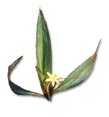
English name: Black musali
Botanical name: Curculigo orchioides
Medicinal uses: Tuberous roots are used for skin ailments. It is considered demulcent, diuretic and tonic. In combination with aromatics and bitters it is used for haemorrhoids, diarrhoea, jaundice and asthma.
English name: Medicinal paddy
Botanical name: Oryza sativa
Medicinal uses: Essential component of Navara kizhi.
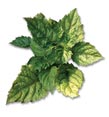
English name: Lodhri
Botanical name: Symplocos laurina
Medicinal uses: Pulverised bark is given with honey for biliousness, haemorrhages,
diarrhoea, gonorrhoea and diseases of the eyes.
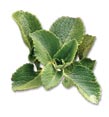
English name: Adjaran
Botanical name: Coleus aromaticus
Medicinal uses: Highly antipyretic, used for urinary diseases. Decoction of leaves is given for chronic cough and asthma. Yields an essential oil containing carvacrol.

English name: Himalayan cherry
Botanical name: Caesalpinia sapans
Medicinal uses: Roots are diuretic and lithontriptic. Powdered leaves are used as a uterine tonic after parturition. Bark and wood of tree is used in thirst quenching preparations. Pathimukham is also considered as anti-cancerous.
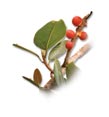
English name: Banyan tree
Botanical name: Ficus bengalensis
Medicinal uses: Latex applied for rheumatism and lumbago. Infusion of bark is considered a tonic and astringent. Also used for diarrhoea, dysentery and diabetes. Leaves are tonic and cooling.
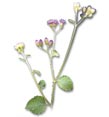
English name: Ash coloured flower
Botanical name: Vernonia cinerea
Medicinal uses: Infusion of the herb in combination with quinine is useful against malaria. Juice is given for incontinence of urine and also for coughs and colic. Roots are bitter and used as anthelmintic. Decoction is given for diarrhoea and stomachache. Flowers are used for fever, rheumatism and conjunctivitis.
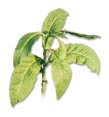
English name: Tobacco
Botanical name: Nicotiana tabacum
Medicinal uses: Used as a sedative, antispasmodic and vermifuge. Also used for gastro-intestinal disorders, skin troubles and local infections.
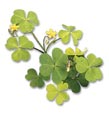
English name: Indian sorrel
Botanical name: Oxalis corniculata
Medicinal uses: Rich in vitamin C and potassium oxalates. Plant is diuretic, anti-scorbutic and refrigerant. Used for liver and digestive disorders, urinary infection, haemorrhage and also to remove cancerous growths from lips.
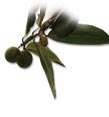
English name: Alexandrian laurel tree
Botanical name: Calophyllum inophyllum
Medicinal uses: Oil is applied for rheumatism and skin infections. Pounded bark is applied for orchites. Juice is purgative. Decoction is employed for inordent ulcers. Tree yields a resin which is emetic and purgative.
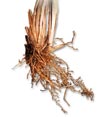
English name: Khas-khas
Botanical name: Vetiveria zizanioides
Medicinal uses: Oil from roots is diaphoretic, stimulant and refrigerant. Used for colic, flatulence, and persistent vomiting. It is applied for relief from rheumatism and lumbago.
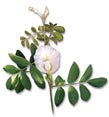
English name: Conch flower
Botanical name: Clitoria ternatea
Medicinal uses: Roots are powerful cathartic and diuretic.
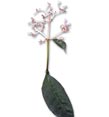
English name: Serpentiana root
Botanical name: Rauvolfia serpentina
Medicinal uses: Used to relieve nervous disorders including anxiety, excitement, maniacal behaviour associated with psychosis, schizophrenia, hypertension etc. Extracts of roots are valued for intestinal troubles. Roots are believed to stimulate uterine contraction. Juice of leaves is used for clearing corneal opacity. Also used as a sedative.
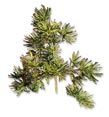
English name: Indian Asparagus
Botanical name: Asparagus racemosus
Medicinal uses: Herb tonic, diuretic, and galactagogue. Fresh root juice is mixed with honey and given for dyspepsia. Roots form a constituent of medicinal oils and are used for nervous and rheumatic complaints. Tubers are cooling and demulcent. Used for cardiac dropsy and chronic gout.
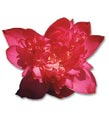
English name: Lotus
Botanical name: Nelumbium nucifera
Medicinal uses: Rhizomes are used for diarrhoea and dysentery in children.
English name: Spreading hogweed
Botanical name: Boerrhavia diffusa
Medicinal uses: Roots are used as expectorant, diuretic and laxative and also for asthma and dropsy associated with chronic Bright's disease. Inflammations like arthritis, joint pain etc, anaemia, ailments of lungs (like cough, asthama etc) gets reduced by the intake of Thazhuthama or Punarnava. It is also used to improve and protect eyesight.
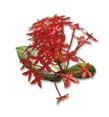
English name: Sacred ixora
Botanical name: Ixora coccinea
Medicinal uses: Thechi is antiseptic and used for sores and chronic ulcers. Roots are stomachic, sedative and used for loss of appetite. Flower decoction is used for eye troubles.
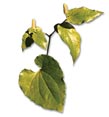
English name: Long pepper
Botanical name: Piper longum
Medicinal uses: Roots and fruits are used for respiratory tract infections and as counter-irritant and analgesic for muscular pains and inflammation. They are used as a snuff for coma and drowsiness or taken internally as a carminative and as a sedative for insomnia and epilepsy. Also used as cholagogue for obstructions of bile duct and gall bladder.
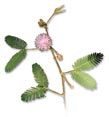
English name: Touch me not
Botanical name: Mimosa pudica
Medicinal uses: Decoction of root is used for gravel and other urinary complaints. Juice of leaves is used for sinusitis and also for sores and haemorrhoids.
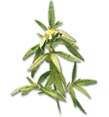
English name: Phlomis
Botanical name: Leucas aspera
Medicinal uses: Juice of the plant is applied externally for psoriasis, chronic skin eruptions and painful swellings. Flowers mixed with honey are good for coughs and colds. Herb is used as an antipyretic.
English name: Malabar nut
Botanical name: Adhatoda vasica
Medicinal uses: Fresh or dried leaves of the plant constitute the drug Vasaka and are also used for bronchial troubles and consumption. Leaf juice is used for glandular tumours. Powdered leaves are used for skin disorders.
English name: Sweet flag root
Botanical name: Acorus calamus
Medicinal uses: Rhizomes are used for epilepsy and mental ailments, chronic diarrhoea, dysentery, glandular and abnormal tumours. Used as sedative and analgesic.
English name: White leadwort
Botanical name: Plumbago zeylanica
Medicinal uses: Roots are abortifacient, vesicant and diuretic, used in dyspepsia, haemorrhoids,
anasarca, diarrhoea and skin diseases. Paste of roots is applied for opening abscesses. Infusion of roots is given for influenza and black-water fever.
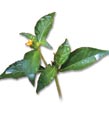
English name: Ash coloured fleabane
Botanical name: Vernonia cinerea
Medicinal uses: Infusion of the herb with quinine makes a useful combination against malaria. Roots are used as anthelmintic, decoction given for diarrhoea and stomachache, juice for coughs, colic and incontinence of urine, flowers for fever, rheumatism and conjunctivitis and seeds to combat thread worms and round worms.
English name: Betel vine
Botanical name: Piper betle
Medicinal uses: Decoction of leaves is used for healing wounds. Roots along with black pepper corns are used to induce sterility in women. Used against diphtheria, as a carminative and as an anti-oxidant.
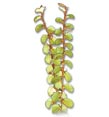
English name: Slender Dwarf Morning Glory
Botanical name: Evolvulus alsinoides
Medicinal uses: Tonic and febrifuge. Also used as vermifuge and for ulcers. Paste mixed with oil promotes growth of hair.